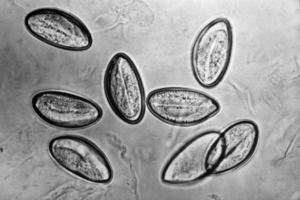Enterobiasis
| Pinworm infection | |
|---|---|
| Synonyms | enterobiasis, oxyuriasis |
 |
|
| Pinworms eggs (Enterobius vermicularis) | |
| Specialty | infectious disease |
| Symptoms | itchy anal area |
| Usual onset | 4 to 8 weeks from exposure |
| Causes | pinworms |
| Risk factors | attending school |
| Diagnostic method | seeing the worms or eggs |
| Medication | mebendazole, pyrantel pamoate, or albendazole |
| Frequency | common |
| Classification | |
|---|---|
| External resources |
Pinworm infection, also known as enterobiasis, is a human parasitic disease caused by the pinworm. The most common symptom is itching in the anal area. This can make sleeping difficult. The period of time from swallowing eggs to the appearance of new eggs around the anus is 4 to 8 weeks. Some people who are infected do not have symptoms.
The disease is spread between people by pinworm eggs. The eggs initially occur around the anus and can survive for up to three weeks in the environment. They may be swallowed following contamination of the hands, food, or other articles. Those at risk are those who go to school, live in a health care institution or prison, or take care of people who are infected. Other animals do not spread the disease. Diagnosis is by seeing the worms which are about one centimeter or the eggs under a microscope.
Treatment is typically with two doses of the medications mebendazole, pyrantel pamoate, or albendazole two weeks apart. Everyone who lives with or takes care of an infected person should be treated at the same time. Washing personal items in hot water after each dose of medication is recommended. Good handwashing, daily bathing in the morning, and daily changing of underwear can help prevent reinfection.
Pinworm infections commonly occur in all parts of the world. It is most common worm infection in the developed world. School aged children are the most commonly infected. In the United States about 20% of people at one point in time develop pinworm. Infection rates among high risk groups may be as high as 50%. It is not considered a serious disease. Pinworms are believed to have affected humans throughout history.
One third of individuals with pinworm infection are totally asymptomatic. The main symptoms are pruritus ani and perineal pruritus, i.e., itching in and around the anus and around the perineum. The itching occurs mainly during the night, and is caused by the female pinworms migrating to lay eggs around the anus. Both the migrating females and the clumps of eggs are irritating, but the mechanisms causing the intense pruritus have not been explained. The intensity of the itching varies, and it can be described as tickling, crawling sensations, or even acute pain. The itching leads to continuously scratching the area around the anus, which can further result in tearing of the skin and complications such as secondary bacterial infections, including bacterial dermatitis (i.e., skin inflammation) and folliculitis (i.e., hair follicle inflammation). General symptoms are insomnia (i.e., persistent difficulties to sleep) and restlessness. A considerable proportion of children suffer from loss of appetite, weight loss, irritability, emotional instability, and enuresis (i.e., inability to control urination).
...
Wikipedia
